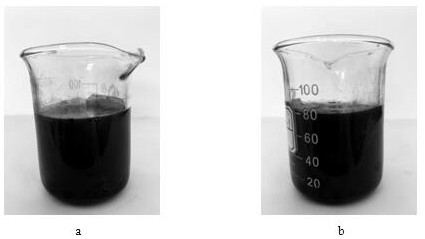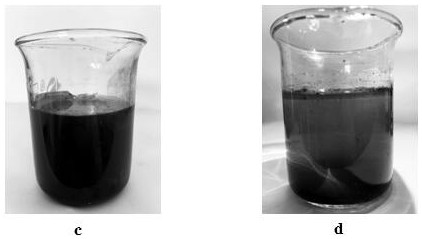Method for improving dispersity of photovoltaic panel electronic paste
An electronic slurry and dispersion technology, applied in the direction of mixing methods, chemical instruments and methods, dissolution, etc., can solve the problems of poor film performance, film pilling and surface unevenness, and achieve the effect of promoting full infiltration
- Summary
- Abstract
- Description
- Claims
- Application Information
AI Technical Summary
Problems solved by technology
Method used
Image
Examples
Embodiment 1
[0027] Dissolve copper acetate in deionized water to prepare a 0.2mol / L solution, slowly add polyacrylamide powder with 10% solution mass and stir until the solution forms a viscous slurry. Add hydrazine hydrate, ammonia water, and EDTA to the viscous slurry, stir and react at 60°C for 20 minutes to form a suspension slurry of nano-copper particles, viscous slurry, hydrazine hydrate with a concentration of 85%, ammonia water with a concentration of 10%, and EDTA The mass ratio is 100:2:21:0.6. Add 0.1mol / L dilute hydrochloric acid dropwise to the suspended slurry until the suspended slurry is neutral, then add p-toluenesulfonyl hydrazide according to 2% of the suspended slurry mass, stir and mix evenly while heating to 80°C and kept stirring for 30 minutes, while stirring and keeping warm, add a saturated sodium carbonate solution dropwise at 1% of the mass of the suspended slurry to obtain a uniformly dispersed mixture without nano-copper clumps. Mix the mixture with glass p...
Embodiment 2
[0029]Dissolve copper acetate in deionized water to prepare a 0.2mol / L solution, slowly add polyacrylamide powder with 11% solution mass and stir until the solution forms a viscous slurry. Add hydrazine hydrate, ammonia water, and EDTA to the viscous slurry, stir and react at 63°C for 20 minutes to form a suspension slurry of copper nanoparticles, viscous slurry, hydrazine hydrate with a concentration of 85%, ammonia water with a concentration of 10%, and EDTA The mass ratio is 100:3:23:0.9. Add 0.1mol / L dilute hydrochloric acid dropwise to the suspended slurry until the suspended slurry is neutral, then add p-toluenesulfonyl hydrazide according to 2% of the suspended slurry mass, stir and mix evenly while heating Stir to 80°C and keep it warm for 30 minutes. While stirring and keeping warm, add a saturated sodium carbonate solution dropwise at 1% of the mass of the suspended slurry to obtain a uniformly dispersed mixture without nano-copper clumps. Mix the mixture with glass...
Embodiment 3
[0031] Dissolve copper acetate in deionized water to prepare a 0.2mol / L solution, slowly add polyacrylamide powder with 13% solution mass and stir until the solution forms a viscous slurry. Add hydrazine hydrate, ammonia water, and EDTA to the viscous slurry, stir and react at 65°C for 25 minutes to form a suspension slurry of nano-copper particles, viscous slurry, hydrazine hydrate with a concentration of 85%, ammonia water with a concentration of 10%, and EDTA The mass ratio is 100:4:27:1.3. Add 0.1mol / L dilute hydrochloric acid dropwise to the suspended slurry until the suspended slurry is neutral, then add p-toluenesulfonyl hydrazide at 2.5% of the suspended slurry mass, stir and mix evenly while heating to 80°C and kept stirring for 35 minutes. While stirring and keeping warm, 1% of the suspended slurry mass was added dropwise with saturated sodium carbonate solution to obtain a uniformly dispersed mixture without nano-copper clumps. Mix the mixture with glass powder and...
PUM
| Property | Measurement | Unit |
|---|---|---|
| Concentration | aaaaa | aaaaa |
Abstract
Description
Claims
Application Information
 Login to View More
Login to View More - R&D
- Intellectual Property
- Life Sciences
- Materials
- Tech Scout
- Unparalleled Data Quality
- Higher Quality Content
- 60% Fewer Hallucinations
Browse by: Latest US Patents, China's latest patents, Technical Efficacy Thesaurus, Application Domain, Technology Topic, Popular Technical Reports.
© 2025 PatSnap. All rights reserved.Legal|Privacy policy|Modern Slavery Act Transparency Statement|Sitemap|About US| Contact US: help@patsnap.com


